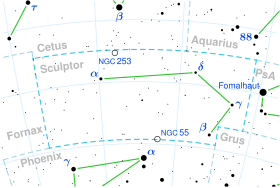Star in the constellation Sculptor
ζ Sculptoris
Observation dataEpoch J2000 Equinox J2000
Constellation
Sculptor
Right ascension
00 02 19.92035
Declination
−29° 43′ 13.4873″
Apparent magnitude (V)
5.04
Characteristics
Spectral type
B5 V
U−B color index
-0.55
B−V color index
-0.16
Astrometry Radial velocity (Rv )+8.6±1.6 km/s Proper motion (μ) RA: +9.34 mas /yr Dec.: +14.50 mas /yr Parallax (π)6.49 ± 0.25 mas Distance 500 ± 20 ly pc ) Absolute magnitude (MV )−0.89 Orbit Period (P)1,740±22 d Eccentricity (e)0.316±0.043 Periastron epoch (T)2453381 ± 37 JD Argument of periastron (ω)43.5±6.9° Semi-amplitude 1 )12.4±0.6 km/s Details Mass 5.5 M ☉ Luminosity 496 L ☉ Temperature 16,100 K Metallicity 0.00 dex Rotation 1.75222 d Rotational velocity (v sin i )15 km/s Other designations ζ Scl , CD −30° 19790, FK5 3932, GC 33337, HD 224990, HIP 183, HR 9091, SAO 135551, CCDM J00023-2943AB, WDS J00023-2943AB, GSC 06418-01221 Database references SIMBAD data
Zeta Sculptoris , Latinized from ζ Sculptoris, is a multiple star system in the constellation Sculptor . It is faintly visible to the naked eye with an apparent magnitude of 5.04. The annual parallax shift is 6.49 mas , which yields a distance estimate of about 500 light years from the Sun. It is moving further away with a radial velocity of +8.6 km/s. Zeta Sculptoris is near the Blanco 1 cluster as viewed from Earth, although parallax measurements indicate it to be substantially closer.
The primary component, designated Zeta Sculptoris A, is a single-lined, low amplitude spectroscopic binary system with an orbital period of 4.8 years and an eccentricity of 0.32. The visible member of this pair is a B-type main-sequence star with a stellar classification of B5 V. It has a 13th magnitude companion, Zeta Sculptoris B, at an angular separation of 3 arcseconds along a position angle of 330° (as of 1927). According to Eggleton and Tokovinin (2008), it is most likely gravitationally bound to the primary component.
References
^ Van Leeuwen, F. (2007). "Validation of the new Hipparcos reduction". Astronomy and Astrophysics . 474 (2): 653–664. arXiv :0708.1752 . Bibcode :2007A&A...474..653V . doi :10.1051/0004-6361:20078357 . S2CID 18759600 . Vizier catalog entry
^ Anderson, E.; Francis, Ch. (2012). "XHIP: An extended hipparcos compilation". Astronomy Letters . 38 (5): 331. arXiv :1108.4971 . Bibcode :2012AstL...38..331A . doi :10.1134/S1063773712050015 . S2CID 119257644 . Vizier catalog entry
^ Zorec, J.; Cidale, L.; Arias, M. L.; Frémat, Y.; Muratore, M. F.; Torres, A. F.; Martayan, C. (2009). "Fundamental parameters of B supergiants from the BCD system". Astronomy and Astrophysics . 501 (1): 297–320. arXiv :0903.5134 . Bibcode :2009A&A...501..297Z . doi :10.1051/0004-6361/200811147 . S2CID 14969137 .
^ Mallama, A. (2014). "Sloan Magnitudes for the Brightest Stars". The Journal of the American Association of Variable Star Observers . 42 (2): 443. Bibcode :2014JAVSO..42..443M . Vizier catalog entry
^ Gontcharov, G. A. (2006). "Pulkovo Compilation of Radial Velocities for 35 495 Hipparcos stars in a common system". Astronomy Letters . 32 (11): 759–771. arXiv :1606.08053 . Bibcode :2006AstL...32..759G . doi :10.1134/S1063773706110065 . S2CID 119231169 .
^ González, J. F.; Levato, H. (November 2009), "Spectroscopic study of the open cluster Blanco 1", Astronomy and Astrophysics , 507 (1): 541–547, Bibcode :2009A&A...507..541G , doi :10.1051/0004-6361/200912772
Tetzlaff, N.; Neuhäuser, R.; Hohle, M. M. (2011). "A catalogue of young runaway Hipparcos stars within 3 kpc from the Sun" . Monthly Notices of the Royal Astronomical Society . 410 (1): 190–200. arXiv :1007.4883 . Bibcode :2011MNRAS.410..190T . doi :10.1111/j.1365-2966.2010.17434.x . S2CID 118629873 . Vizier catalog entry
Gontcharov, G. A. (2012). "Dependence of kinematics on the age of stars in the solar neighborhood". Astronomy Letters . 38 (12): 771–782. arXiv :1606.08814 . Bibcode :2012AstL...38..771G . doi :10.1134/S1063773712120031 . S2CID 118345778 . Vizier catalog entry
Barraza, L. F.; Gomes, R. L.; Messias, Y. S.; Leão, I. C.; Almeida, L. A.; Janot-Pacheco, E.; Brito, A. C.; Brito, F. A. C.; Santana, J. V.; Gonçalves, N. S.; Das Chagas, M. L.; Teixeira, M. A.; De Medeiros, J. R.; Canto Martins, B. L. (2022). "Rotation Signature of TESS B-type Stars. A Comprehensive Analysis" . The Astrophysical Journal . 924 (2): 117. arXiv :2202.01022 . Bibcode :2022ApJ...924..117B . doi :10.3847/1538-4357/ac3335 . S2CID 246030494 .
Abt, Helmut A.; Levato, Hugo; Grosso, Monica (2002). "Rotational Velocities of B Stars" . The Astrophysical Journal . 573 (1): 359–365. Bibcode :2002ApJ...573..359A . doi :10.1086/340590 .
Mason, Brian D.; Wycoff, Gary L.; Hartkopf, William I.; Douglass, Geoffrey G.; Worley, Charles E. (2001). "The 2001 US Naval Observatory Double Star CD-ROM. I. The Washington Double Star Catalog" . The Astronomical Journal . 122 (6): 3466. Bibcode :2001AJ....122.3466M . doi :10.1086/323920 . Vizier catalog entry
Eggleton, P. P.; Tokovinin, A. A. (2008). "A catalogue of multiplicity among bright stellar systems" . Monthly Notices of the Royal Astronomical Society . 389 (2): 869. arXiv :0806.2878 . Bibcode :2008MNRAS.389..869E . doi :10.1111/j.1365-2966.2008.13596.x . S2CID 14878976 .
Categories :
Zeta Sculptoris
Add topic
Text is available under the Creative Commons Attribution-ShareAlike License. Additional terms may apply.
**DISCLAIMER** We are not affiliated with Wikipedia, and Cloudflare.
The information presented on this site is for general informational purposes only and does not constitute medical advice.
You should always have a personal consultation with a healthcare professional before making changes to your diet, medication, or exercise routine.
AI helps with the correspondence in our chat.
We participate in an affiliate program. If you buy something through a link, we may earn a commission 💕
↑
